Abstract
1. The conduction velocities of individual motor axons innervating twitch and slow muscle fibres of the frog were determined by intracellular recording of junctional potentials elicited by stimulating the motor nerves at two different points. 2. In normal pyriformis muscles twitch and slow fibres were found to be innervated by two distinct populations of motor axons. Twitch fibre axons conducted at 10-18-7 m/sec, while the conduction velocities of slow fibre axons ranged from 0-5 to 5 m/sec (at 7-9 degrees C). The thresholds for electrical stimulation were significantly lower in the fast than in the slow axons population. 3. Following denervation by crushing the sciatic nerve fast axons which re-innervated the muscle had lower conduction velocities than normal but could still be identified. These lower conduction velocities were measured proximal to the site of the crush and did not recover over a period of 446 days. 4. Fast motor axons regenerated more quickly than slow axons and re-innervated twitch as well as slow muscle fibres non-selectively. About 1 month later slow axons re-established synaptic contacts with slow (and some twitch) muscle fibres. Simultaneous re-innervation by fast and slow motor axons was occasionally observed in slow muscle fibres. Finally, the slow muscle fibres were innervated by slow axons only, while synapses of fast axons could no longer be found in this type of muscle fibre. 5. Action potentials were observed in denervated as well as in re-innervated slow muscle fibres; they disappeared as re-innervation progressed. 6. It is concluded that non-selective re-innervation of slow muscle fibres is present in the frog; it is, however, a transient phenomenon followed by restoration of the original innervation pattern.
Full text
PDF
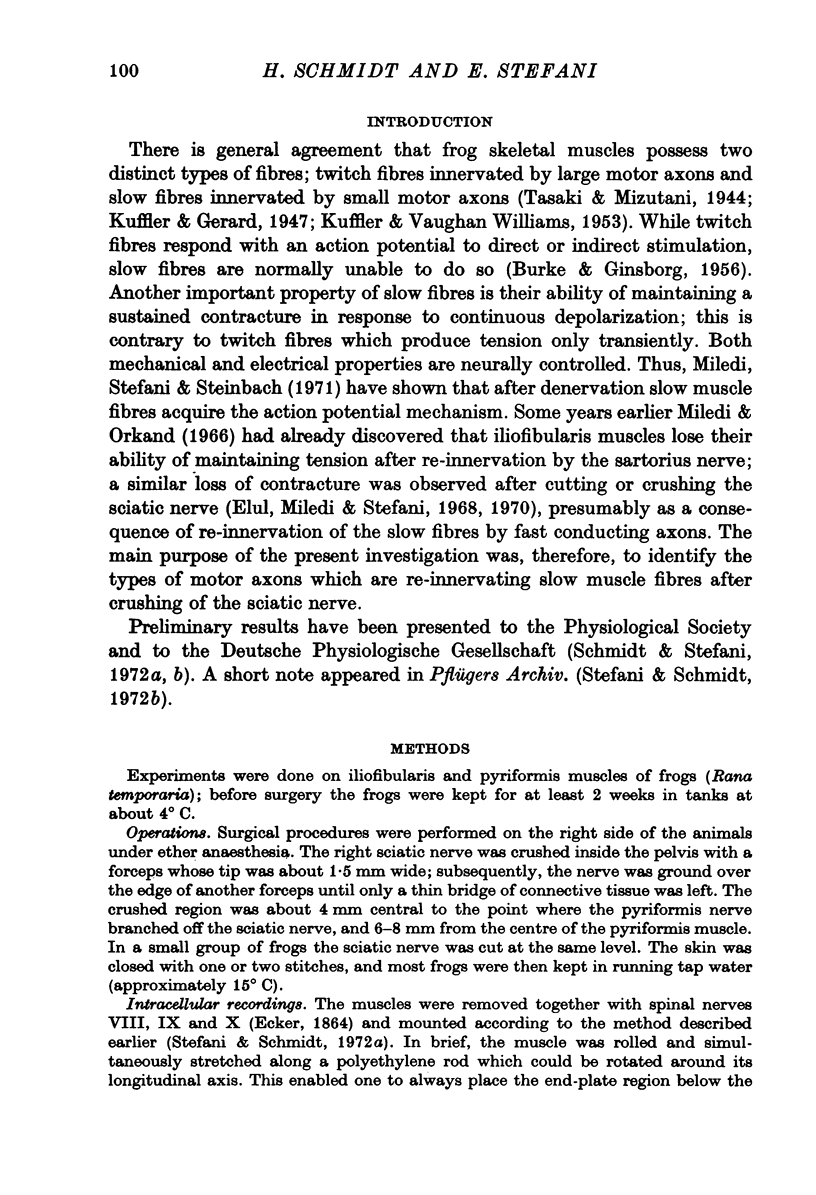


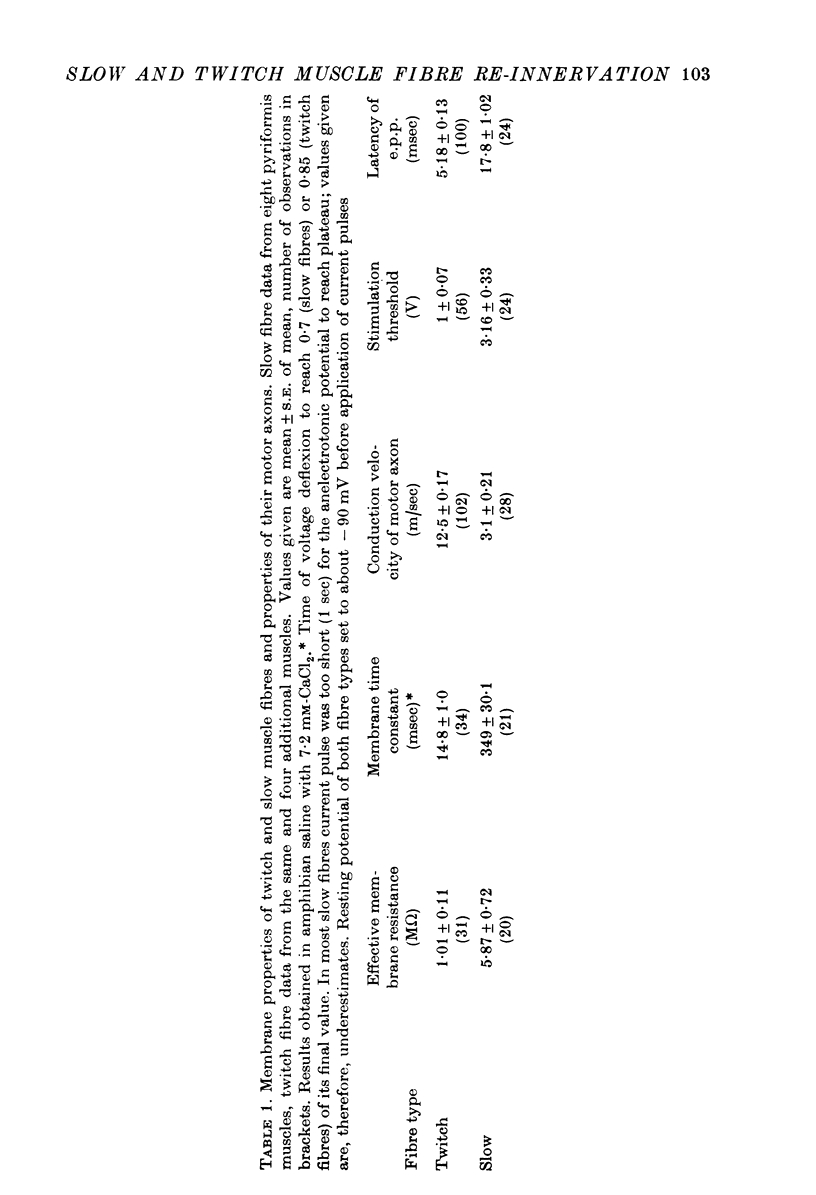

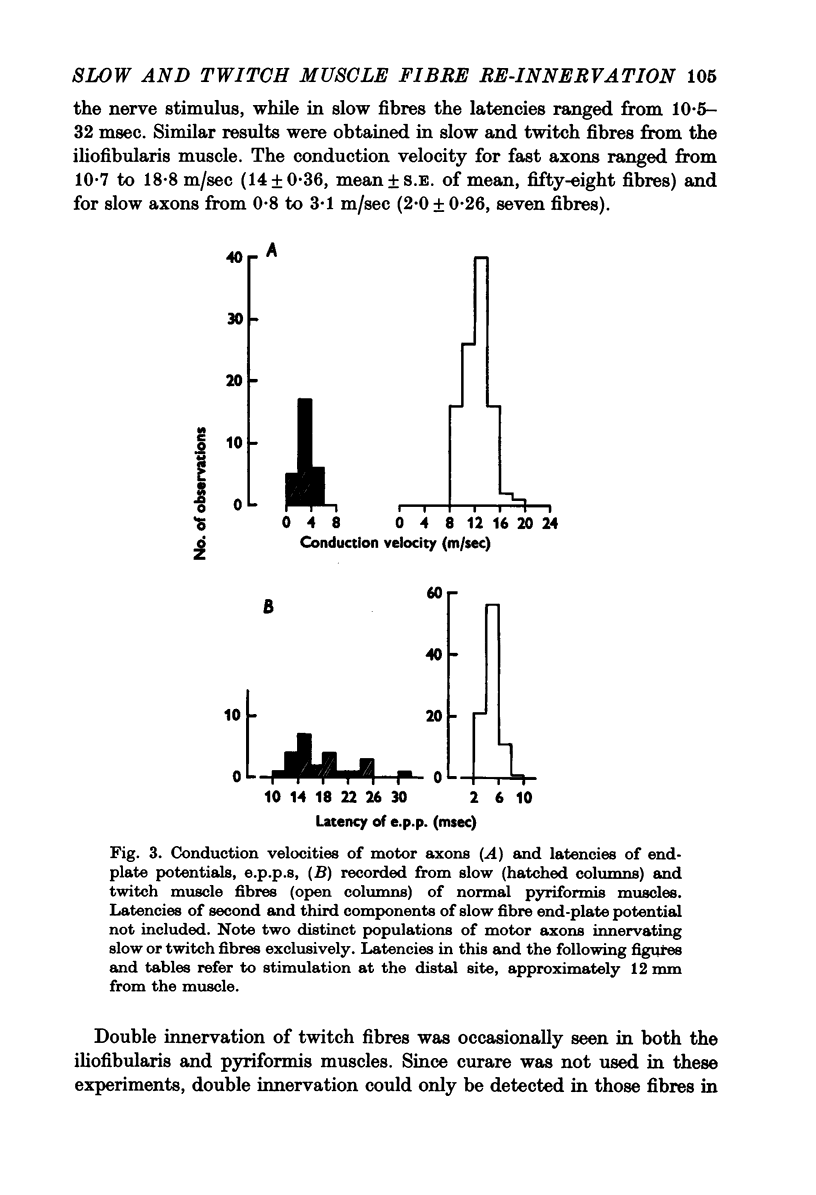




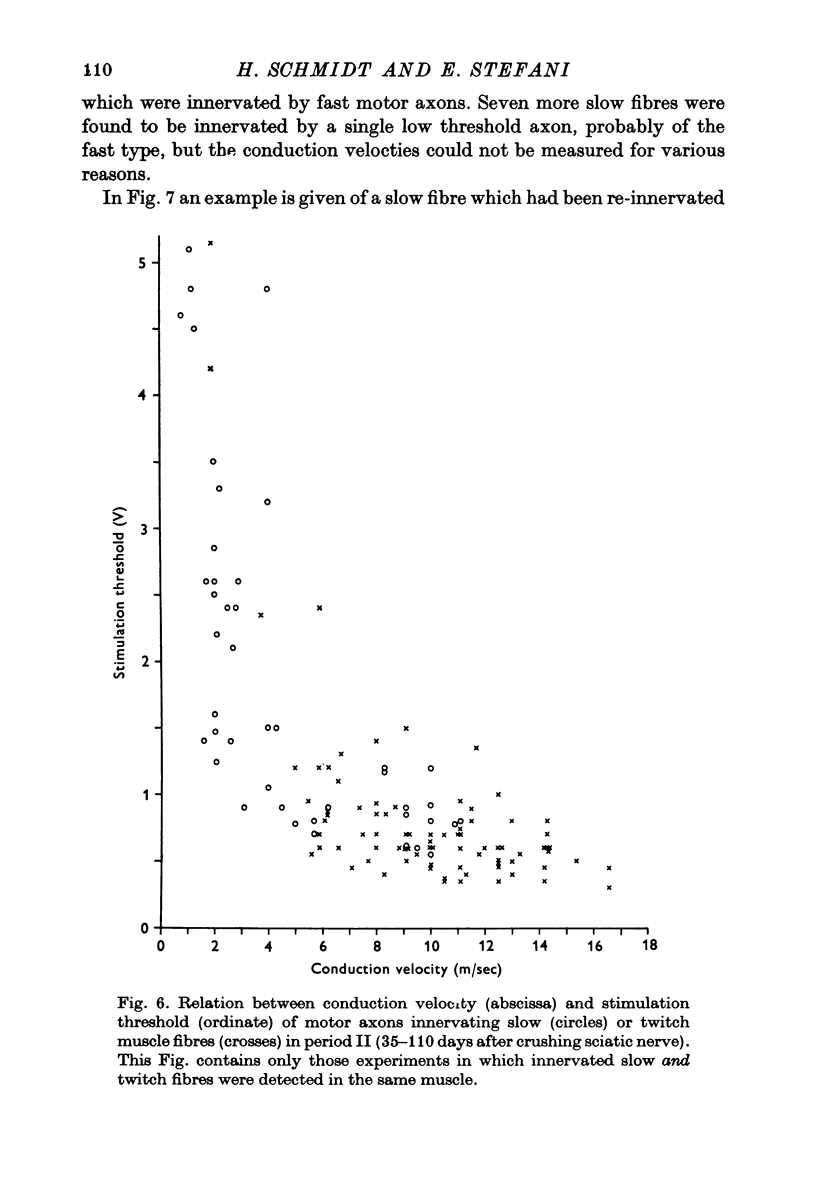


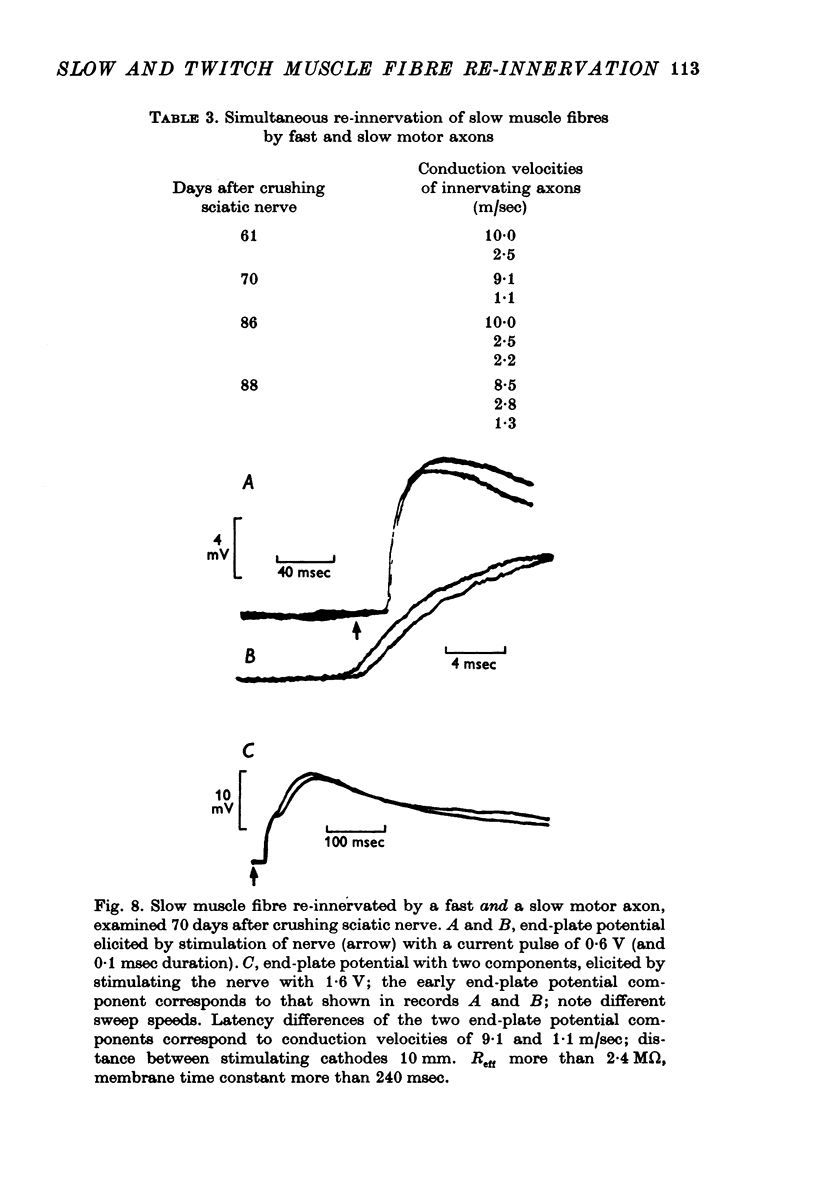

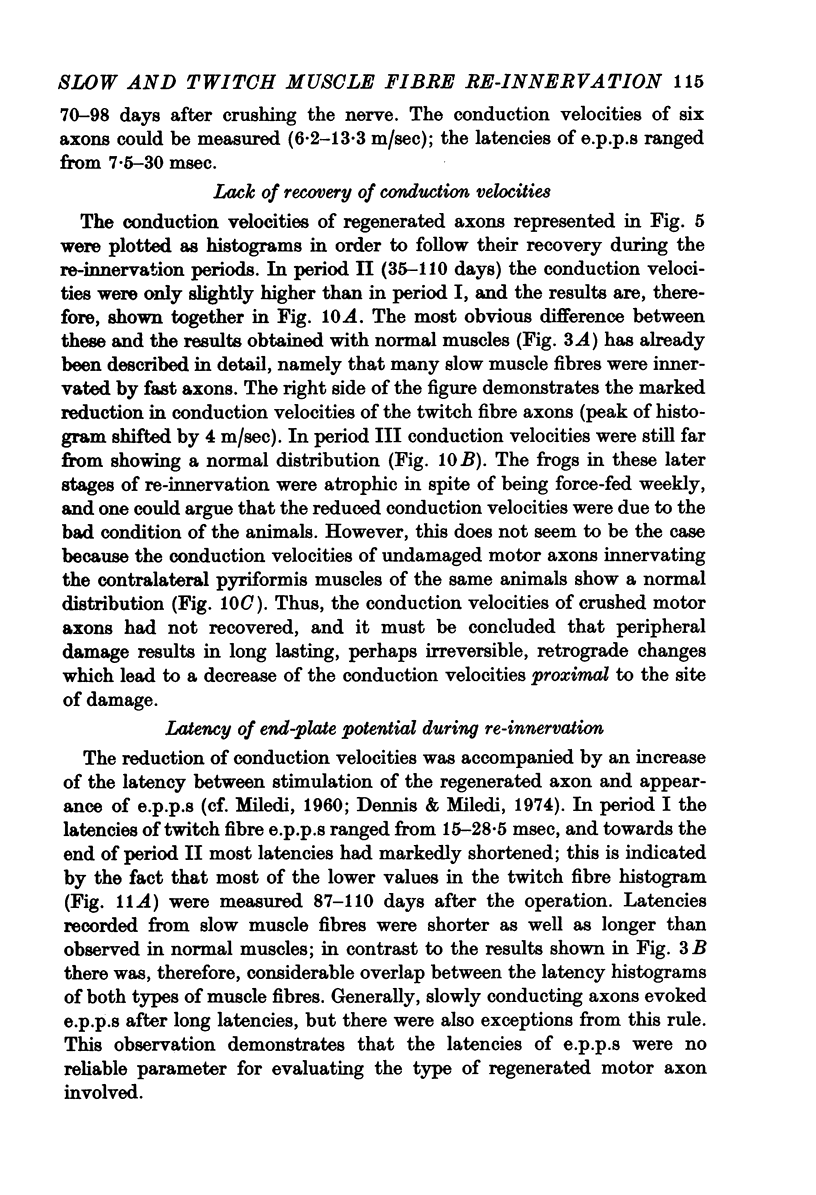

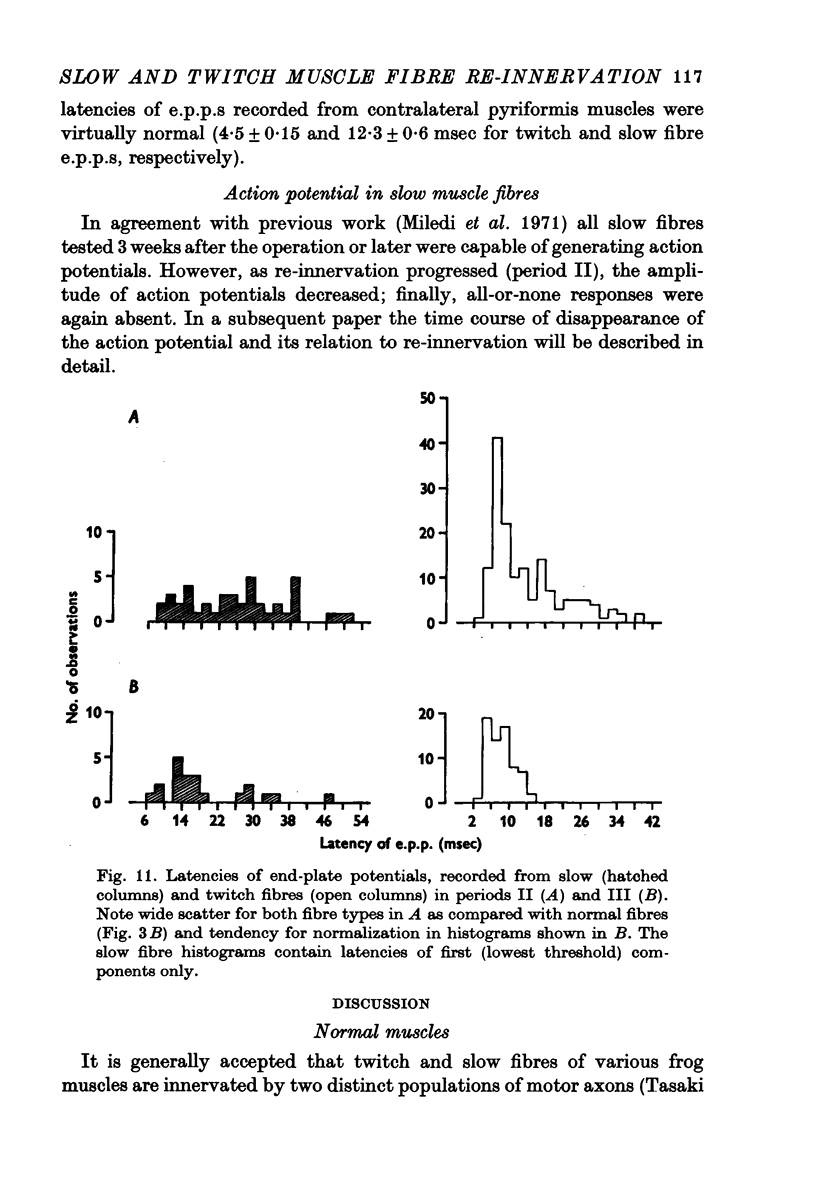
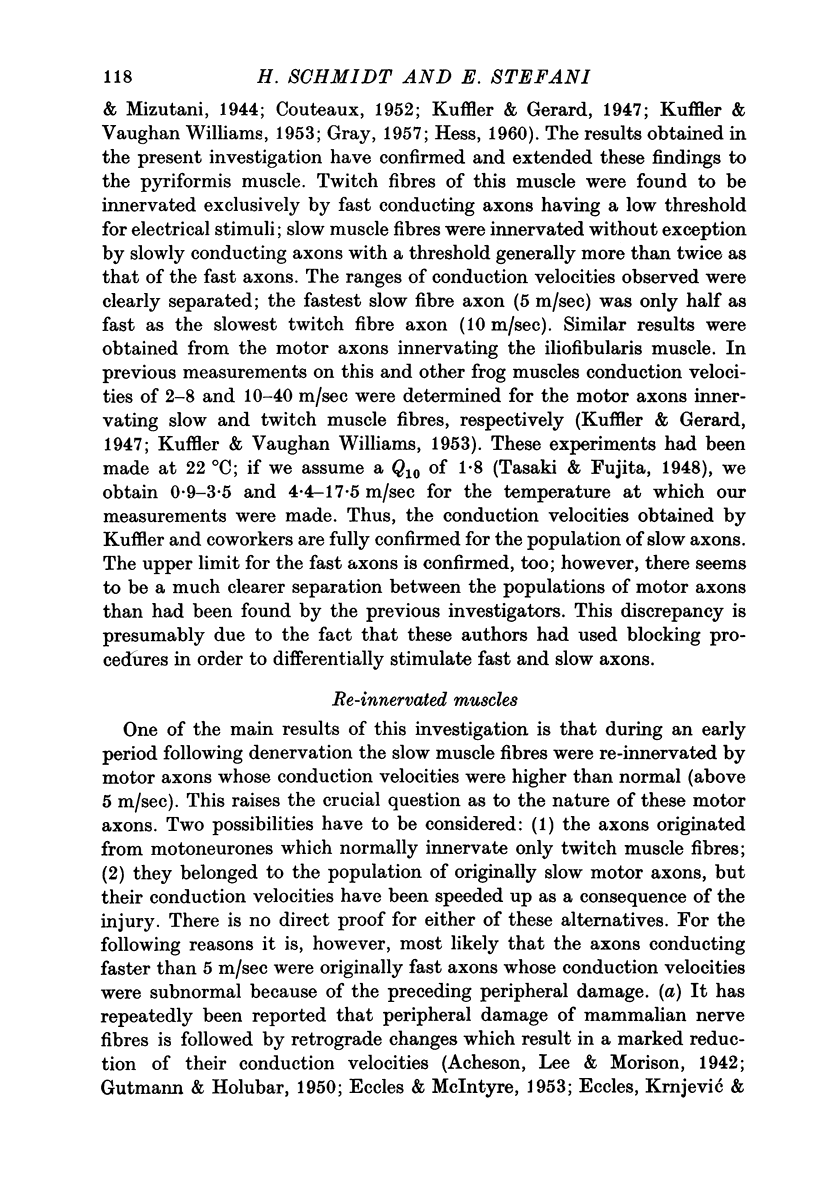
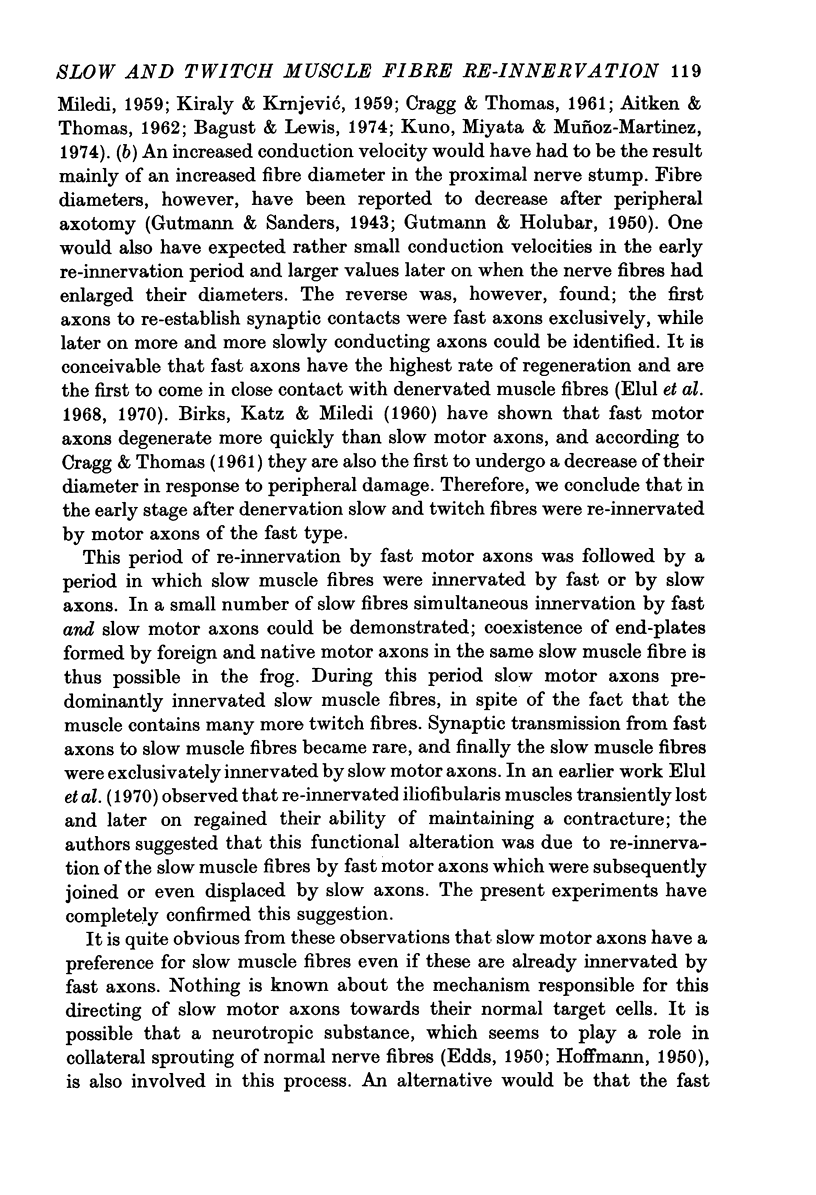

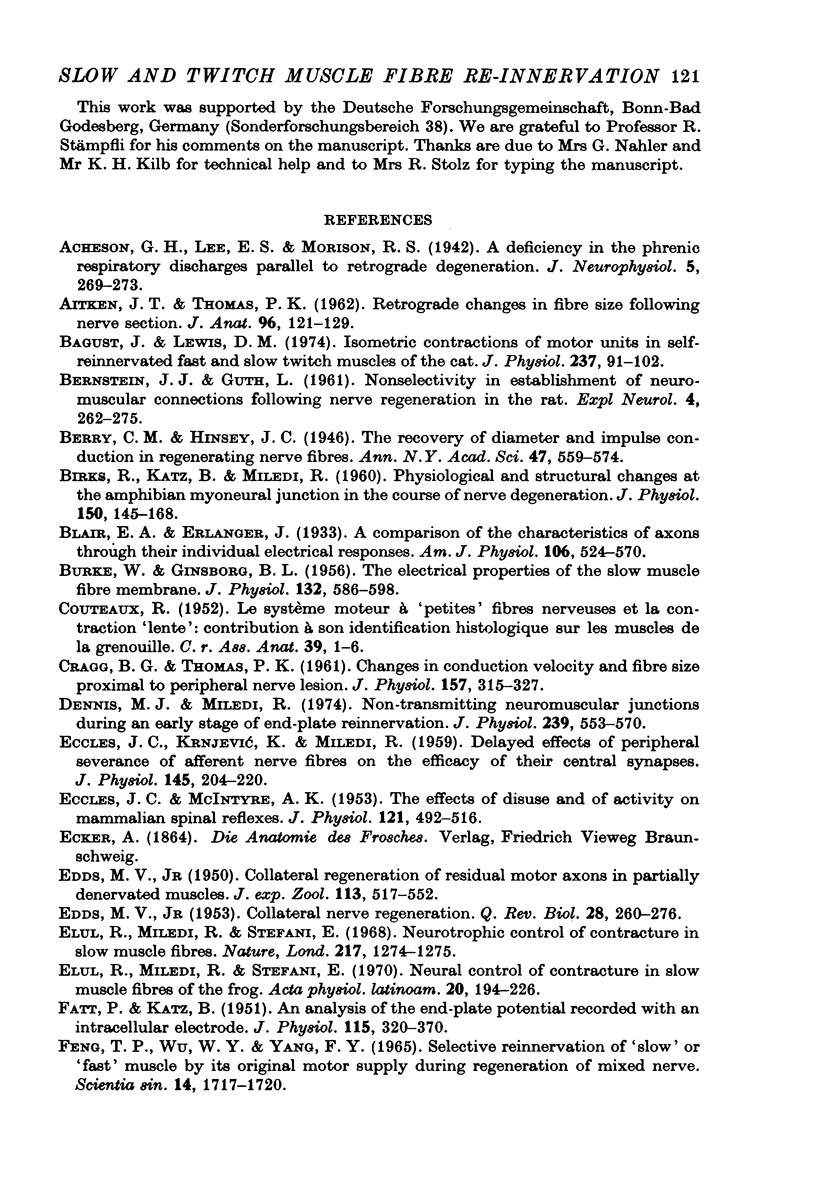
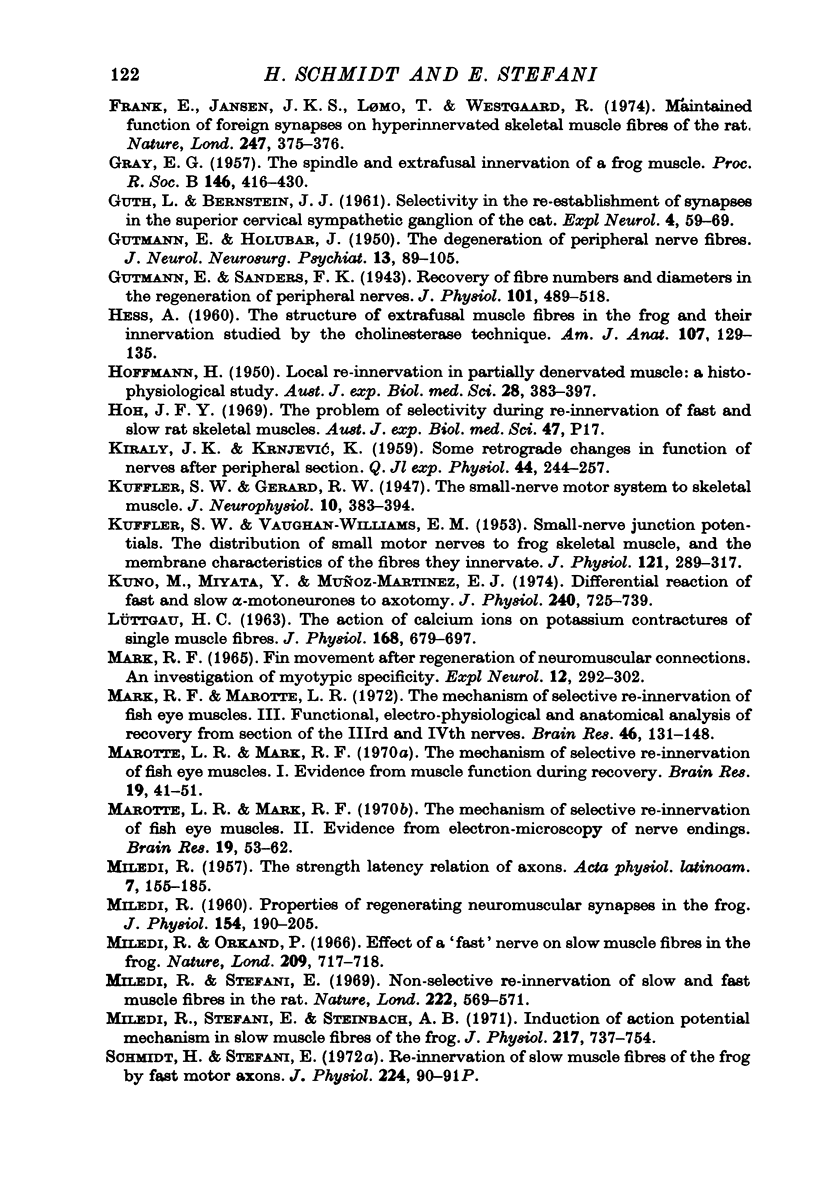

Selected References
These references are in PubMed. This may not be the complete list of references from this article.
- AITKEN J. T., THOMAS P. K. Retrograde changes in fibre size following nerve section. J Anat. 1962 Jan;96:121–129. [PMC free article] [PubMed] [Google Scholar]
- BERNSTEIN J. J., GUTH L. Nonselectivity in establishment of neuromuscular connections following nerve regeneration in the rat. Exp Neurol. 1961 Sep;4:262–275. doi: 10.1016/0014-4886(61)90047-4. [DOI] [PubMed] [Google Scholar]
- BIRKS R., KATZ B., MILEDI R. Physiological and structural changes at the amphibian myoneural junction, in the course of nerve degeneration. J Physiol. 1960 Jan;150:145–168. doi: 10.1113/jphysiol.1960.sp006379. [DOI] [PMC free article] [PubMed] [Google Scholar]
- BURKE W., GINSBORG B. L. The electrical properties of the slow muscle fibre membrane. J Physiol. 1956 Jun 28;132(3):586–598. doi: 10.1113/jphysiol.1956.sp005551. [DOI] [PMC free article] [PubMed] [Google Scholar]
- Bagust J., Lewis D. M. Isometric contractions of motor units in self-reinnervated fast and slow twitch muscles of the cat. J Physiol. 1974 Feb;237(1):91–102. doi: 10.1113/jphysiol.1974.sp010471. [DOI] [PMC free article] [PubMed] [Google Scholar]
- CRAGG B. G., THOMAS P. K. Changes in conduction velocity and fibre size proximal to peripheral nerve lesions. J Physiol. 1961 Jul;157:315–327. doi: 10.1113/jphysiol.1961.sp006724. [DOI] [PMC free article] [PubMed] [Google Scholar]
- Dennis M. J., Miledi R. Non-transmitting neuromuscular junctions during an early stage of end-plate reinnervation. J Physiol. 1974 Jun;239(3):553–570. doi: 10.1113/jphysiol.1974.sp010582. [DOI] [PMC free article] [PubMed] [Google Scholar]
- ECCLES J. C., KRNJEVIC K., MILEDI R. Delayed effects of peripheral severance of afferent nerve fibres on the efficacy of their central synapses. J Physiol. 1959 Jan 28;145(1):204–220. doi: 10.1113/jphysiol.1959.sp006136. [DOI] [PMC free article] [PubMed] [Google Scholar]
- ECCLES J. C., McINTYRE A. K. The effects of disuse and of activity on mammalian spinal reflexes. J Physiol. 1953 Sep;121(3):492–516. doi: 10.1113/jphysiol.1953.sp004961. [DOI] [PMC free article] [PubMed] [Google Scholar]
- EDDS M. V., Jr Collateral nerve regeneration. Q Rev Biol. 1953 Sep;28(3):260–276. doi: 10.1086/399699. [DOI] [PubMed] [Google Scholar]
- Elul R., Miledi R., Stefani E. Neural control of contracture in slow muscle fibres of the frog. Acta Physiol Lat Am. 1970;20(3):194–226. [PubMed] [Google Scholar]
- Elul R., Miledi R., Stefani E. Neurotrophic control of contracture in slow muscle fibres. Nature. 1968 Mar 30;217(5135):1274–1275. doi: 10.1038/2171274a0. [DOI] [PubMed] [Google Scholar]
- FATT P., KATZ B. An analysis of the end-plate potential recorded with an intracellular electrode. J Physiol. 1951 Nov 28;115(3):320–370. doi: 10.1113/jphysiol.1951.sp004675. [DOI] [PMC free article] [PubMed] [Google Scholar]
- Frank E., Jansen J. K., Lomo T., Westgaard R. Maintained function of foreign synapses on hyperinnervated skeletal muscle fibres of the rat. Nature. 1974 Feb 8;247(5440):375–376. doi: 10.1038/247375a0. [DOI] [PubMed] [Google Scholar]
- GRAY E. G. The spindle and extrafusal innervation of a frog muscle. Proc R Soc Lond B Biol Sci. 1957 May 7;146(924):416–430. doi: 10.1098/rspb.1957.0021. [DOI] [PubMed] [Google Scholar]
- GUTH L., BERNSTEIN J. J. Selectivity in the re-establishment of synapses in the superior cervical sympathetic ganglion of the cat. Exp Neurol. 1961 Jul;4:59–69. doi: 10.1016/0014-4886(61)90078-4. [DOI] [PubMed] [Google Scholar]
- GUTMANN E., HOLUBAR J. The degeneration of peripheral nerve fibers. J Neurol Neurosurg Psychiatry. 1950 May;13(2):89–105. doi: 10.1136/jnnp.13.2.89. [DOI] [PMC free article] [PubMed] [Google Scholar]
- Gutmann E., Sanders F. K. Recovery of fibre numbers and diameters in the regeneration of peripheral nerves. J Physiol. 1943 Mar 25;101(4):489–518. doi: 10.1113/jphysiol.1943.sp004002. [DOI] [PMC free article] [PubMed] [Google Scholar]
- HOFFMAN H. Local re-innervation in partially denervated muscle; a histophysiological study. Aust J Exp Biol Med Sci. 1950 Jul;28(4):383–397. doi: 10.1038/icb.1950.39. [DOI] [PubMed] [Google Scholar]
- KUFFLER S. W., VAUGHAN WILLIAMS E. M. Small-nerve junctional potentials; the distribution of small motor nerves to frog skeletal muscle, and the membrane characteristics of the fibres they innervate. J Physiol. 1953 Aug;121(2):289–317. doi: 10.1113/jphysiol.1953.sp004948. [DOI] [PMC free article] [PubMed] [Google Scholar]
- Kuno M., Miyata Y., Muñoz-Martinez E. J. Differential reaction of fast and slow alpha-motoneurones to axotomy. J Physiol. 1974 Aug;240(3):725–739. doi: 10.1113/jphysiol.1974.sp010631. [DOI] [PMC free article] [PubMed] [Google Scholar]
- MILEDI R. Properties of regenerating neuromuscular synapses in the frog. J Physiol. 1960 Nov;154:190–205. doi: 10.1113/jphysiol.1960.sp006573. [DOI] [PMC free article] [PubMed] [Google Scholar]
- Mark R. F., Marotte L. R. The mechanism of selective reinnervation of fish eye muscles. 3. Functional, electrophysiological and anatomical analysis of recovery from section of 3rd and IVth nerves. Brain Res. 1972 Nov 13;46:131–148. doi: 10.1016/0006-8993(72)90011-x. [DOI] [PubMed] [Google Scholar]
- Marotte L. R., Mark R. F. The mechanism of selective reinnervation of fish eye muscle. I. Evidence from muscle function during recovery. Brain Res. 1970 Apr 1;19(1):41–51. doi: 10.1016/0006-8993(70)90235-0. [DOI] [PubMed] [Google Scholar]
- Miledi R., Orkand P. Effect of a "fast" nerve on "slow" muscle fibres in the frog. Nature. 1966 Feb 12;209(5024):717–718. doi: 10.1038/209717a0. [DOI] [PubMed] [Google Scholar]
- Miledi R., Stefani E. Non-selective re-innervation of slow and fast muscle fibres in the rat. Nature. 1969 May 10;222(5193):569–571. doi: 10.1038/222569a0. [DOI] [PubMed] [Google Scholar]
- Miledi R., Stefani E., Steinbach A. B. Induction of the action potential mechanism in slow muscle fibres of the frog. J Physiol. 1971 Sep;217(3):737–754. doi: 10.1113/jphysiol.1971.sp009597. [DOI] [PMC free article] [PubMed] [Google Scholar]
- Schmidt H., Stefani E. Re-innervation of slow muscle fibres of the frog by fast motor axons. J Physiol. 1972 Jul;224(2):90P–91P. [PubMed] [Google Scholar]
- Stefani E., Schmidt H. A convenient method for repeated intracellular recording of action potentials from the same muscle fibre without membrane damage. Pflugers Arch. 1972;334(3):276–278. doi: 10.1007/BF00626229. [DOI] [PubMed] [Google Scholar]
- Stefani E., Schmidt H. Early stage of re-innervation of frog slow muscle fibres. Pflugers Arch. 1972;336(3):271–275. doi: 10.1007/BF00590051. [DOI] [PubMed] [Google Scholar]
- Stefani E., Steinbach A. B. Resting potential and electrical properties of frog slow muscle fibres. Effect of different external solutions. J Physiol. 1969 Aug;203(2):383–401. doi: 10.1113/jphysiol.1969.sp008869. [DOI] [PMC free article] [PubMed] [Google Scholar]


